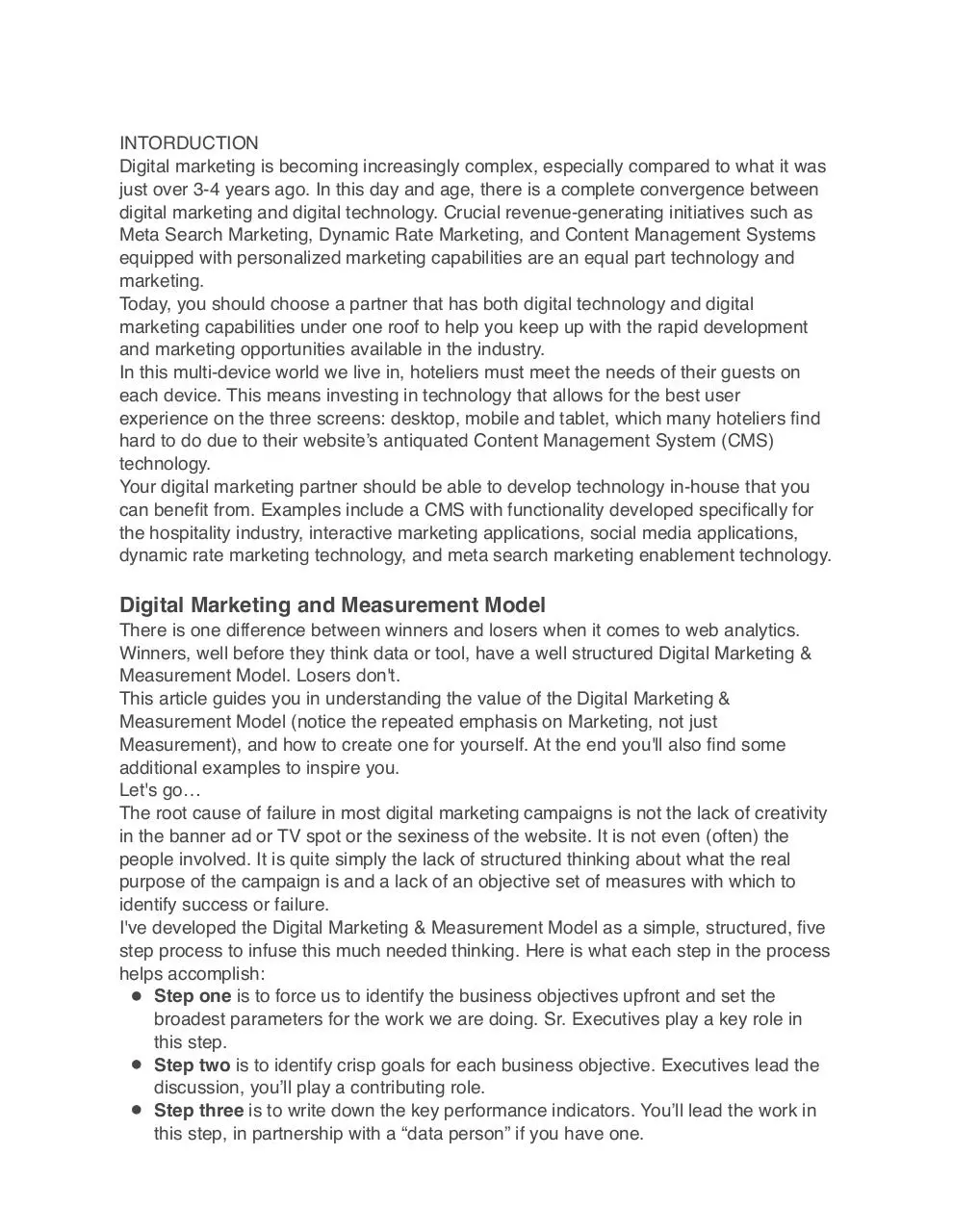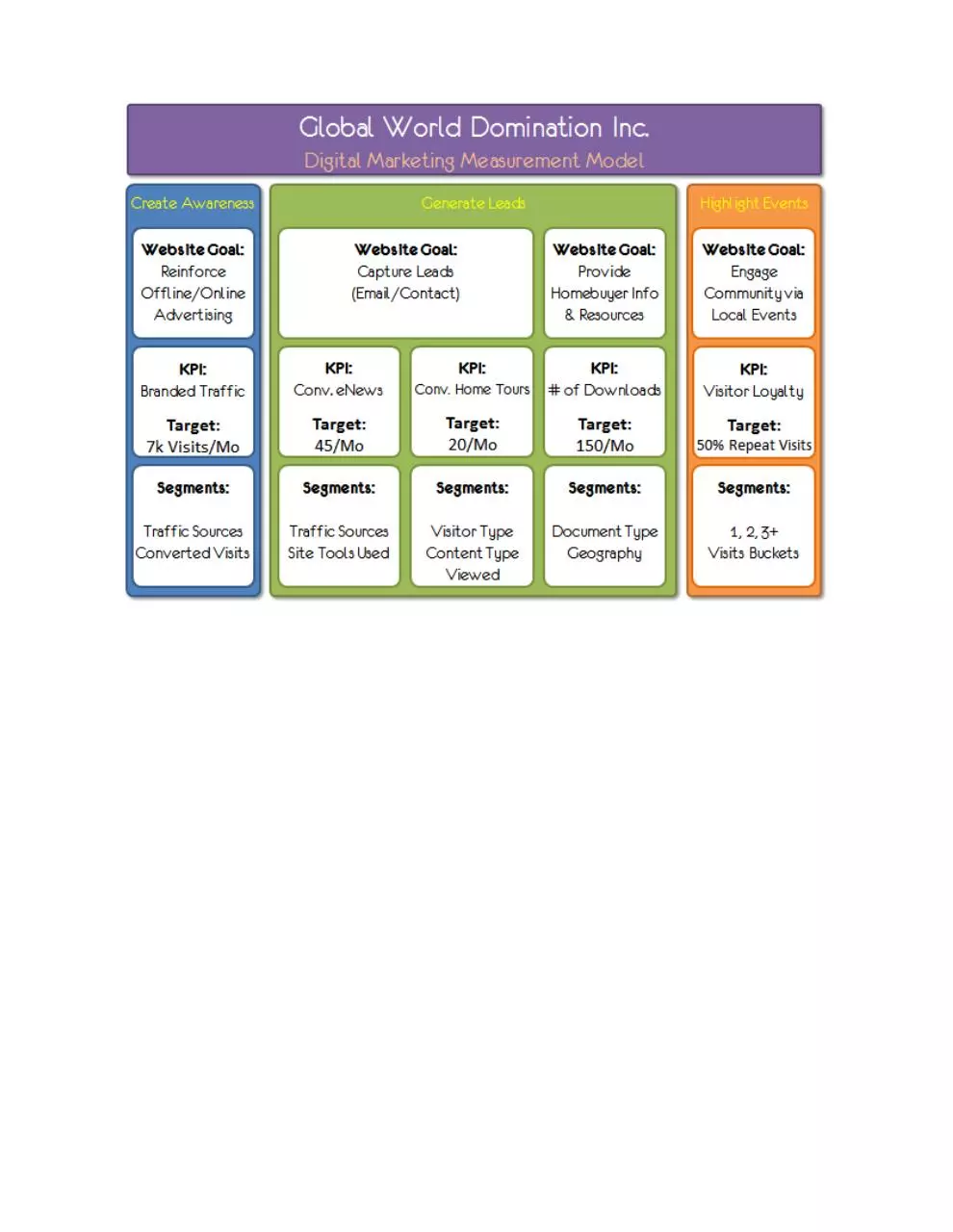INTORDUCTION (PDF)
File information
Title: INTORDUCTION
This PDF 1.3 document has been generated by Notes / Mac OS X 10.11.5 Quartz PDFContext, and has been sent on pdf-archive.com on 27/06/2016 at 16:26, from IP address 121.244.x.x.
The current document download page has been viewed 323 times.
File size: 208.41 KB (5 pages).
Privacy: public file





File preview
INTORDUCTION
Digital marketing is becoming increasingly complex, especially compared to what it was
just over 3-4 years ago. In this day and age, there is a complete convergence between
digital marketing and digital technology. Crucial revenue-generating initiatives such as
Meta Search Marketing, Dynamic Rate Marketing, and Content Management Systems
equipped with personalized marketing capabilities are an equal part technology and
marketing.
Today, you should choose a partner that has both digital technology and digital
marketing capabilities under one roof to help you keep up with the rapid development
and marketing opportunities available in the industry.
In this multi-device world we live in, hoteliers must meet the needs of their guests on
each device. This means investing in technology that allows for the best user
experience on the three screens: desktop, mobile and tablet, which many hoteliers find
hard to do due to their website’s antiquated Content Management System (CMS)
technology.
Your digital marketing partner should be able to develop technology in-house that you
can benefit from. Examples include a CMS with functionality developed specifically for
the hospitality industry, interactive marketing applications, social media applications,
dynamic rate marketing technology, and meta search marketing enablement technology.
Digital Marketing and Measurement Model
There is one difference between winners and losers when it comes to web analytics.
Winners, well before they think data or tool, have a well structured Digital Marketing &
Measurement Model. Losers don't.
This article guides you in understanding the value of the Digital Marketing &
Measurement Model (notice the repeated emphasis on Marketing, not just
Measurement), and how to create one for yourself. At the end you'll also find some
additional examples to inspire you.
Let's go…
The root cause of failure in most digital marketing campaigns is not the lack of creativity
in the banner ad or TV spot or the sexiness of the website. It is not even (often) the
people involved. It is quite simply the lack of structured thinking about what the real
purpose of the campaign is and a lack of an objective set of measures with which to
identify success or failure.
I've developed the Digital Marketing & Measurement Model as a simple, structured, five
step process to infuse this much needed thinking. Here is what each step in the process
helps accomplish:
● Step one is to force us to identify the business objectives upfront and set the
broadest parameters for the work we are doing. Sr. Executives play a key role in
this step.
● Step two is to identify crisp goals for each business objective. Executives lead the
discussion, you’ll play a contributing role.
● Step three is to write down the key performance indicators. You’ll lead the work in
this step, in partnership with a “data person” if you have one.
●
Step four is to set the parameters for success upfront by identifying targets for
each KPI. Organization leaders play a key role here, with input from Marketing and
Finance.
● Step five, finally, is to identify the segments of people / behavior / outcomes that
we’ll analyze to understand why we succeed or failed.
Simple, right? It is harder than you might think, “soft” work always is. Before we go into
each step in detail I want to share something extremely critical. The scope/breadth the
model has to cover.
A complete, and competent, Digital Marketing & Measurement Model will focus on three
key areas of your marketing, and in each answer the cluster of questions provided:
● 1. Acquisition.
○ How are you anticipating acquiring traffic for your website / YT video / whatever
else you are creating? Did you cover all three components of successful
acquisition: Earned, Owned, Paid media? How would you prioritize each?
Where are you spending most of your efforts?
● 2. Behavior.
○ What is the behavior you are expecting when people arrive? What pages
should they see? What videos should they watch? Should they visit
repeatedly? Are there certain actions they should take? What is unique about
your effort that ties to an optimal experience for a customer?
● 3. Outcomes.
○ What outcomes signify value delivered to the business bottom-line? A
download? A phone call to your call center? A qualified online lead? Signing up
for email promotions? People buying your product / services ? A 95% task
completion rate? A 10 point lift in brand perception?
Step 1: Identify the Business Objectives,Identify Goals for each Objective.
Step 2: Identify the Key Performance Indicators.
● My definition: A key performance indicator (KPI) is a metric that helps you
●
understand how you are doing against your objectives.
Step 3: Identify the Targets.
●
Why do you need targets? Consider this: You had an amazing campaign on
YouTube. You got 1.2 million views. Is that great or awful? How do you decide?
That is why you need targets!
Step 4: Identify valuable Segments for analysis.
Download INTORDUCTION
INTORDUCTION.pdf (PDF, 208.41 KB)
Download PDF
Share this file on social networks
Link to this page
Permanent link
Use the permanent link to the download page to share your document on Facebook, Twitter, LinkedIn, or directly with a contact by e-Mail, Messenger, Whatsapp, Line..
Short link
Use the short link to share your document on Twitter or by text message (SMS)
HTML Code
Copy the following HTML code to share your document on a Website or Blog
QR Code to this page

This file has been shared publicly by a user of PDF Archive.
Document ID: 0000394595.